When it comes to erotic art, there is a case to be made for leaving something to the imagination. There is nothing less sensual, more mechanical, than a bares-all sex scene. No narrative is more predictable than that of pornography (I wonder what happens next?).
We all know that sex sells. But the question of how to define sex – and not just sex but, rather, sexiness – is rather more difficult to answer. In fact, it is so difficult to do sex well that there was famously a Bad Sex Award run by the Literary Review between 1993 and 2020.
A litany of artworks have been censored owing to the nature of their depiction of sexuality… Gustave Courbet’s L’Origine du Monde (1866) is so graphic that it still gets banned on social media. I’m not posting it here, for fear of my Substack being deleted.
But I wouldn’t describe L’Origine du Monde as especially erotic. It’s subversive and intentionally shocking, and the substance is in its execution. It’s a work which was intended to destabilise and question how we think about, and depict, the female body.
The erotic is something else entirely. It is suggestive, metaphorical, and playful. Eroticism is never really there on the page or the canvas: its real home is the imagination. It’s about frisky glances and light touches, peeping voyeurism, and rich, poetic imagery. You want the viewer or reader to be seduced, but not for them to witness the sex.
Here’s an example. If you were to ask me what the most frisky painting in any London museum is, I’d say Jean-Honoré Fragonard’s The Swing (in the Wallace Collection). Now, there is no outright depiction of sex in this painting. We simply see a happy couple, frolicking in a lush woodland.
However, look closer: the lady, dressed beautifully in frilly, satiny pink, swings gaily through the air. Her skirts are aflutter. Her slipper is falling off. The beau watches from below. Is she wearing underwear? The giggling statue of Cupid on the left (and the red flush of her lover’s face) suggest not.
This is Rococo, through and through. It’s lush and furry and pastel-coloured and full of sexual innuendos. The woman’s recklessly disrobed slipper tells us everything we need to know. It’s totally wanton, without obscenity.
There’s an older man in the background — perhaps the lady’s cuckolded husband — pushing the swing, comically oblivious to the lover-in-the-bushes’ advances. The implied back-and-forth motion of the swing invokes the sexual act. The pink folds of the dress invoke something else. It’s all very cheeky.
The Rococo was a movement in early 18th-century French painting, closely tied to the reign of Louis XV. It was a period of relative stability for the aristocracy, marked by an indulgence in pleasure, beauty, and refined society. During this era, the rigid formalities of court life at Versailles began to change, giving way to a more intimate and relaxed aristocratic culture. Noblemen and women frequented exclusive, elegant salons in Paris, where they socialised, flirted, debauched, and so on.
If you’ve studied the French Revolution, you’ll know that the frivolity of the Rococo came to be despised by the revolutionaries, who saw it as a symbol of the depravity, corruption, and moral decay of a ruling class blind to the struggles of the working man. But that’s a big topic… maybe for another day...
Today, in the spirit of St. Valentine, I want to focus on Rococo fluff. I want to think about lacy petticoats and squishy kisses. In fact, I’m interested in kisses, specifically. Because they are a powerful erotic tool. Kisses incite the imagination, titillating the prospect of sex, whilst also retaining a modicum of innocence.

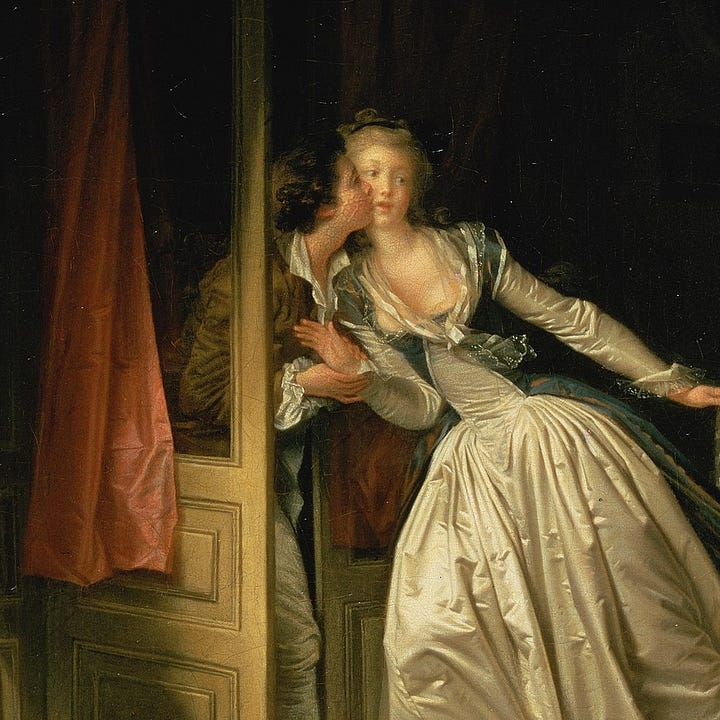
One type of kiss which the Rococo painters are particular to is that of the ‘stolen kiss’ — a sort of unexpected peck. Often, there is a tension between the lovers’ body language (attraction) and facial expressions (surprise) which symbolise the conflict between social decorum and personal desire.
These ‘stolen kisses’ are part of the aristocratic culture of the amour galant (courtly love). They’re games of flirtation and seduction which take place under the watchful eyes of high society. Often there are motifs like curtains, doors, and windows in these ‘stolen kiss’ scenes which symbolise (and scandalise) the hidden nature of these liaisons.
But some French kisses are more innocent than others.
Look at Pierre-Antoine Baudouin’s La Nuit. Under the cover of darkness, these periwigged paramours have snuck out into the garden. The composition is clandestine: the lovers are pinned in the bottom-third, hidden by the thick foliage of the forest and another mischievous Cupid statue.
Thus concealed, they’re rollicking in the loamy rose bushes. The lady’s legs are wide, her ears are blushing and her bosom is bared. The yellow-clad, silk-socked, dandy leans over her. This, I think, is not a stolen kiss, but a warmly welcomed one.
The French kissing scene is associated with a genre called the fête galante (gallant party), which usually depict a courting, aristocratic couple in an outdoor setting. There is often a playful, fertile dynamic, with lush natural greenery suggestive of sexuality. Everything in the painting contributes to impressing an idea of the luxury and wellbeing of the couple (here — the guardian cupid, the fine clothes, and the fertile garden, filled with rich colours and textures). There are always voyeurs — even if they aren’t there in the painting.
(It’s us. We’re the voyeurs).
Anyway, the most enthusiastic of the French kisses are also the most explicit. In the tradition of mythological paintings of the story of Cupid and Psyche, these paintings tend to depict adolescent or young couples (rather than adults) and, more than the amour galant or fête galante genres, start to border on the precipice of pornography. But, really, these aren’t the most fun or exciting Rococo kisses. In fact, I think it’s no surprise that Fragonard’s most successful paintings aren’t the ones where the lovers’ lips touch, but rather in the moments — or hours — before.
Indeed: it’s the anticipation that is beautiful, and worth immortalising. The sex itself is immaterial.
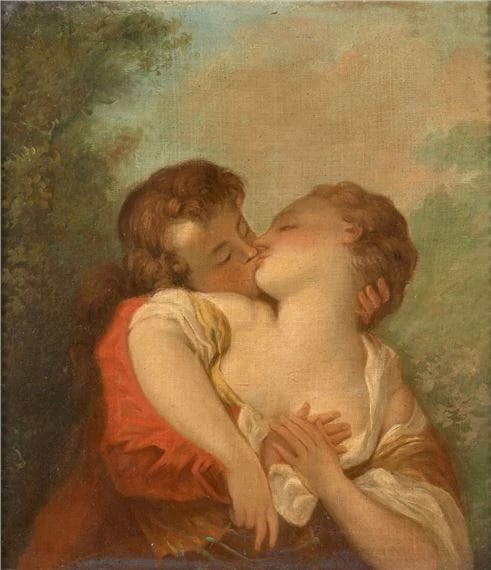
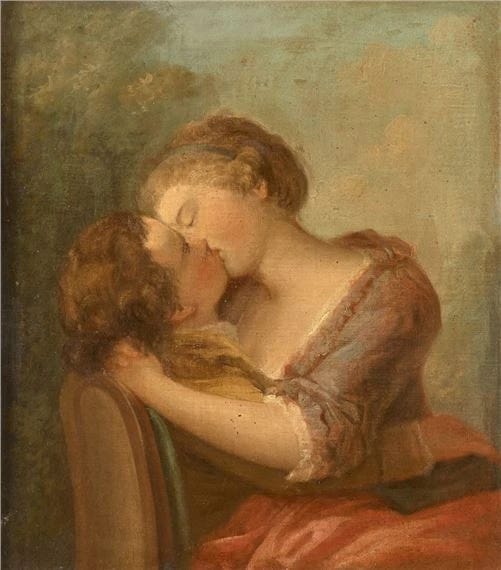
At least, this is what you can tell yourself, if you’re alone this Valentine’s day!
If you want to here me talk more about lovers, art, and the erotic, come see me on the 15th February at Aphrodite’s Archer, an evening symposium hosted by Cosi’s Odyssey. Tickets Here.
Thanks for reading! Check out my Instagram at @culture_dumper, where I post daily updates on my academic work, life, and current exhibitions in London.






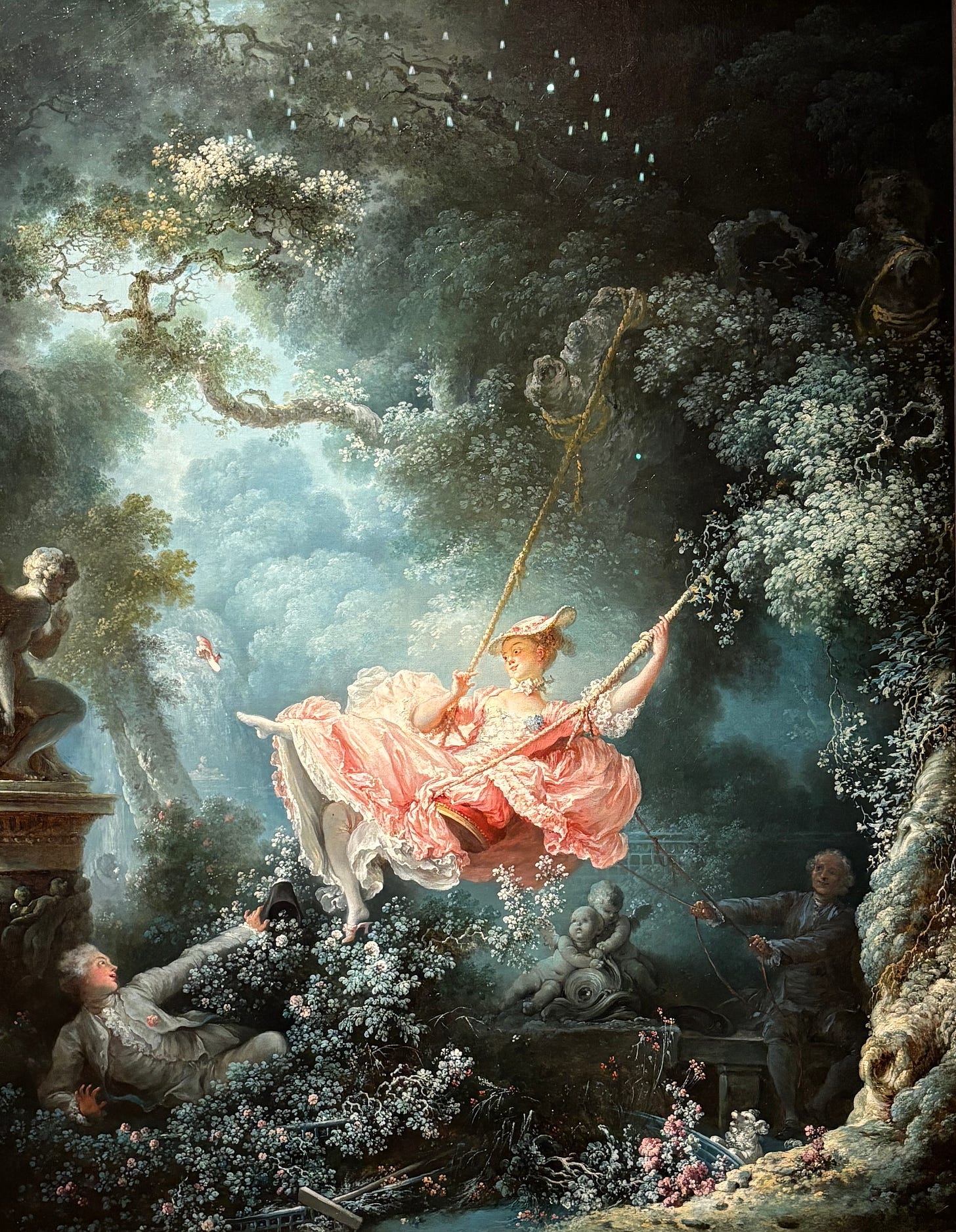

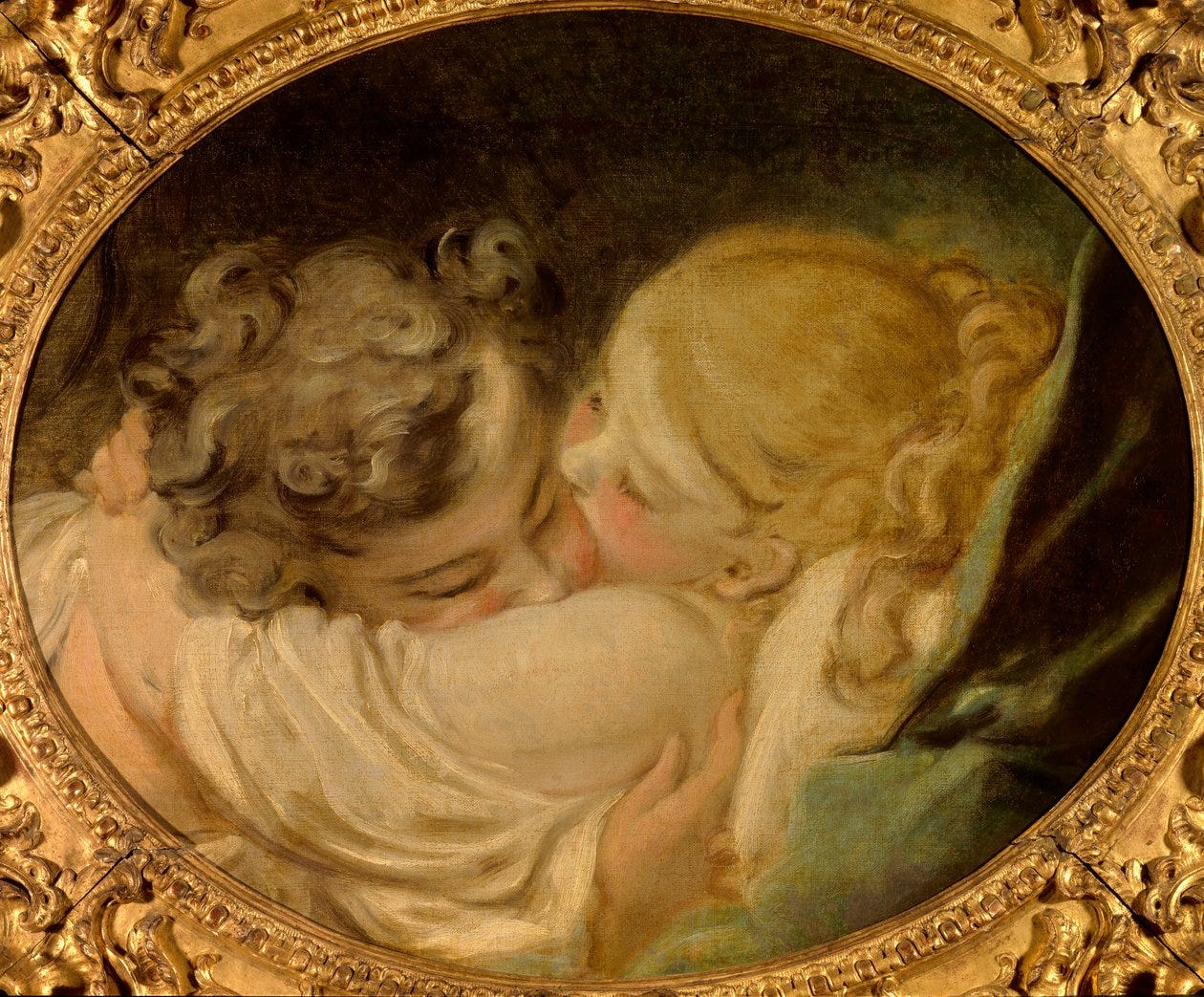
A question from the cheap seats: In The Swing, is it not possible that the lover has been literally knocked off his feet? The surprised, somewhat anguished look on his face. The slightly mischievous look on her face? Perhaps aware of her power over him (so literally depicted). Just a thought, understanding every painting is open to interpretation - to an extent.
This is so wonderful! Thank you for sharing <3